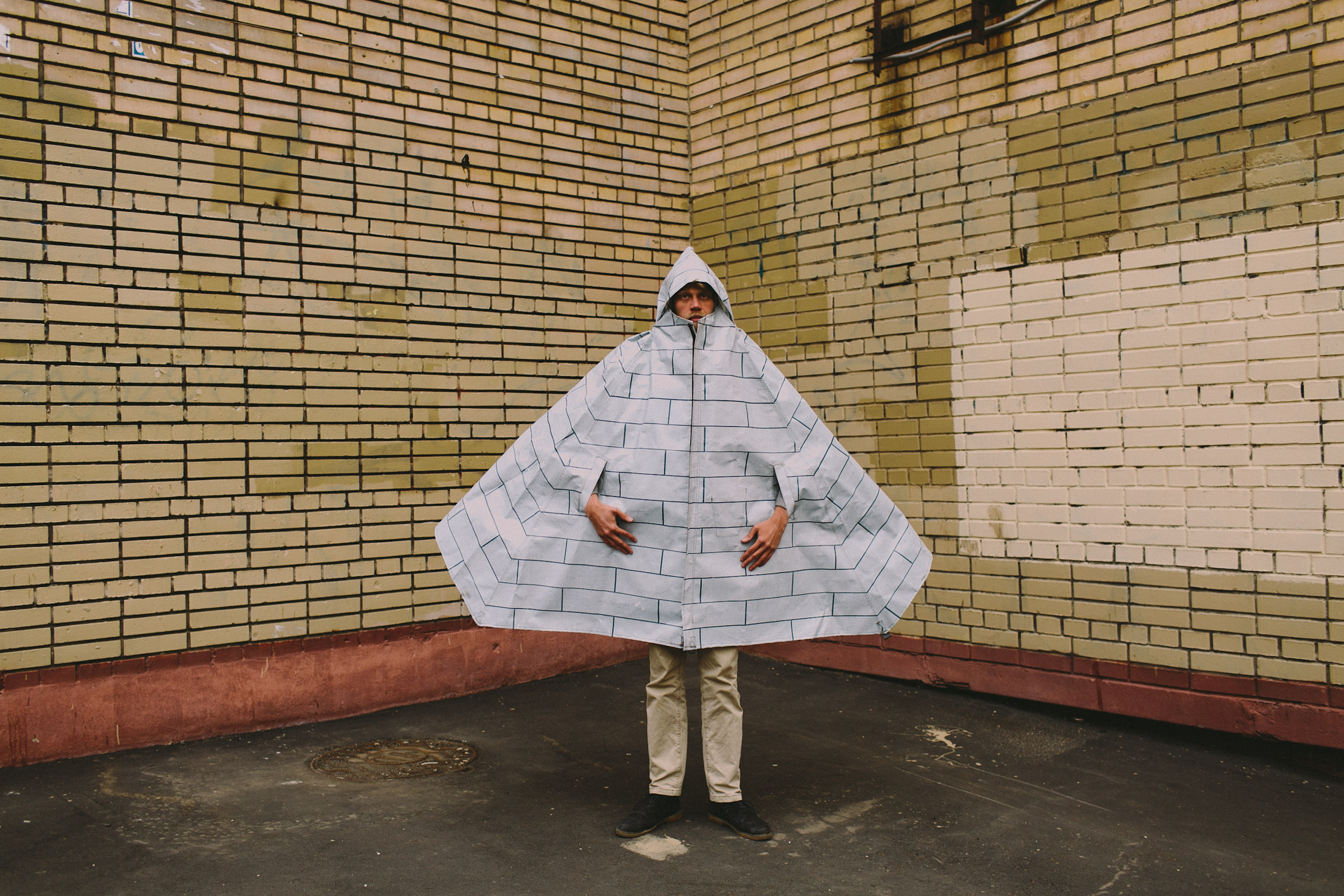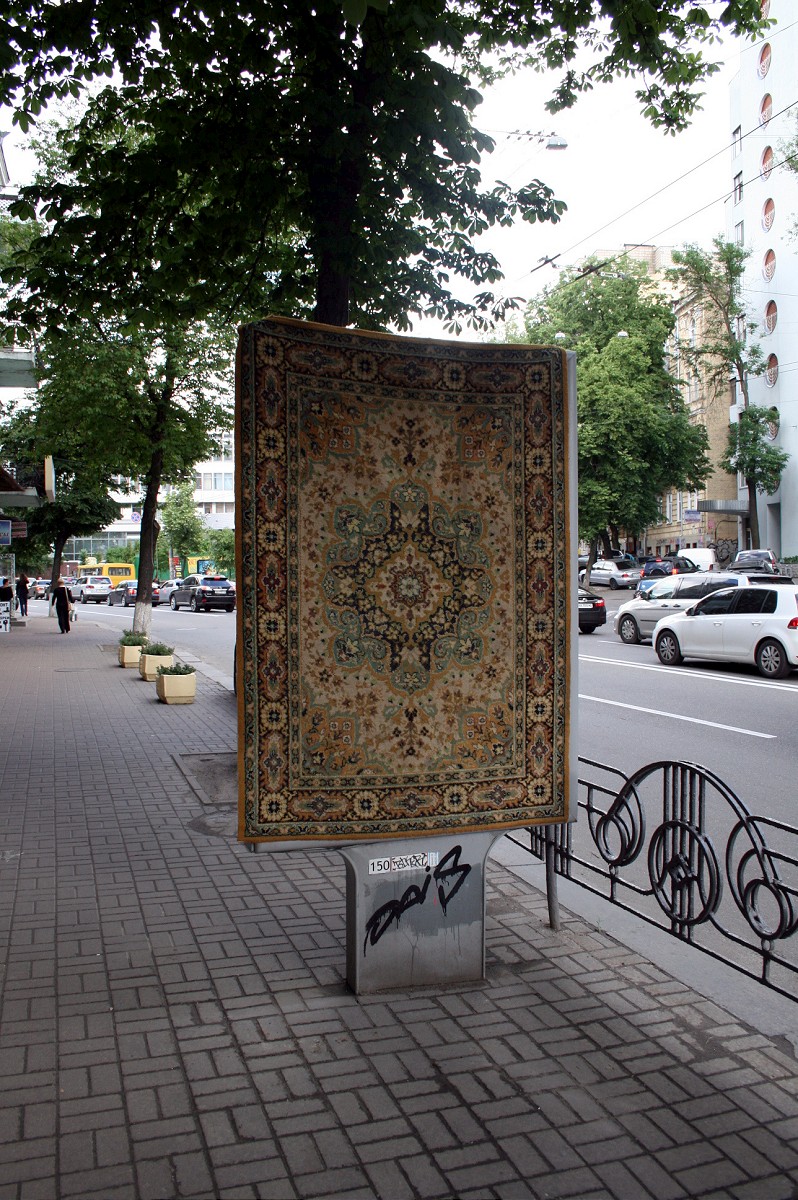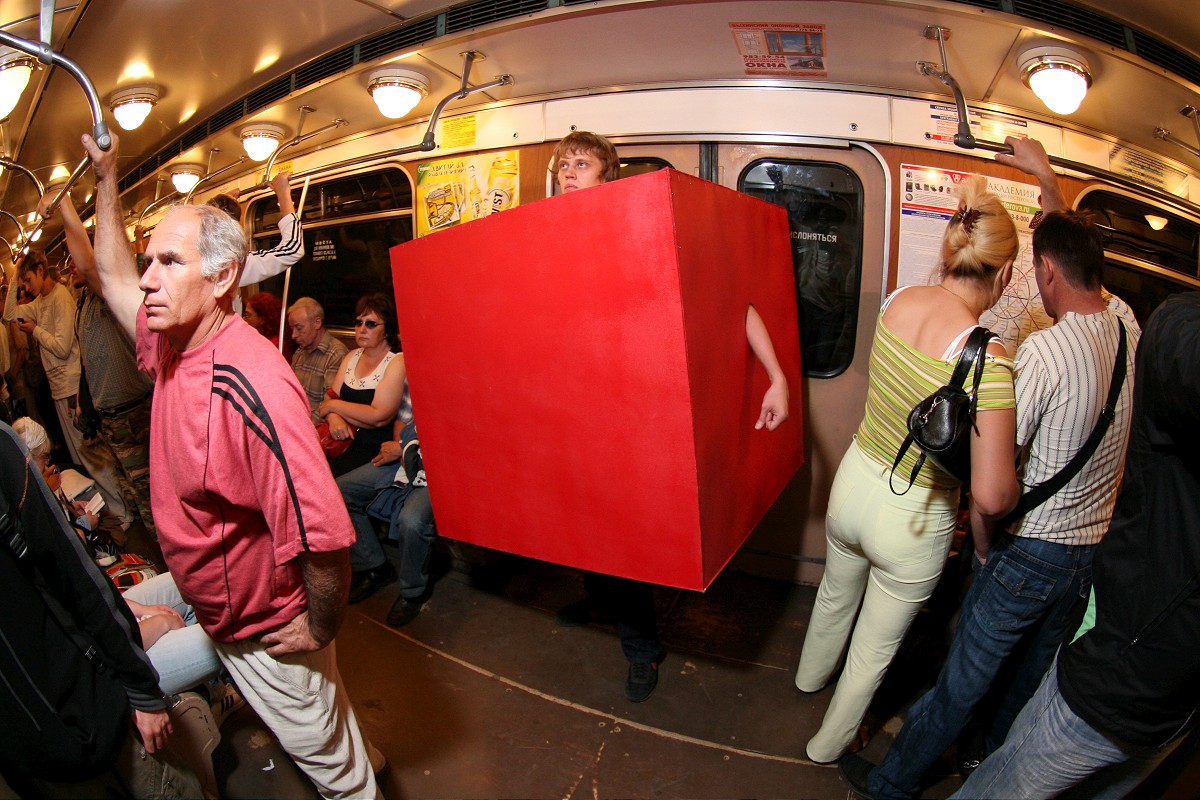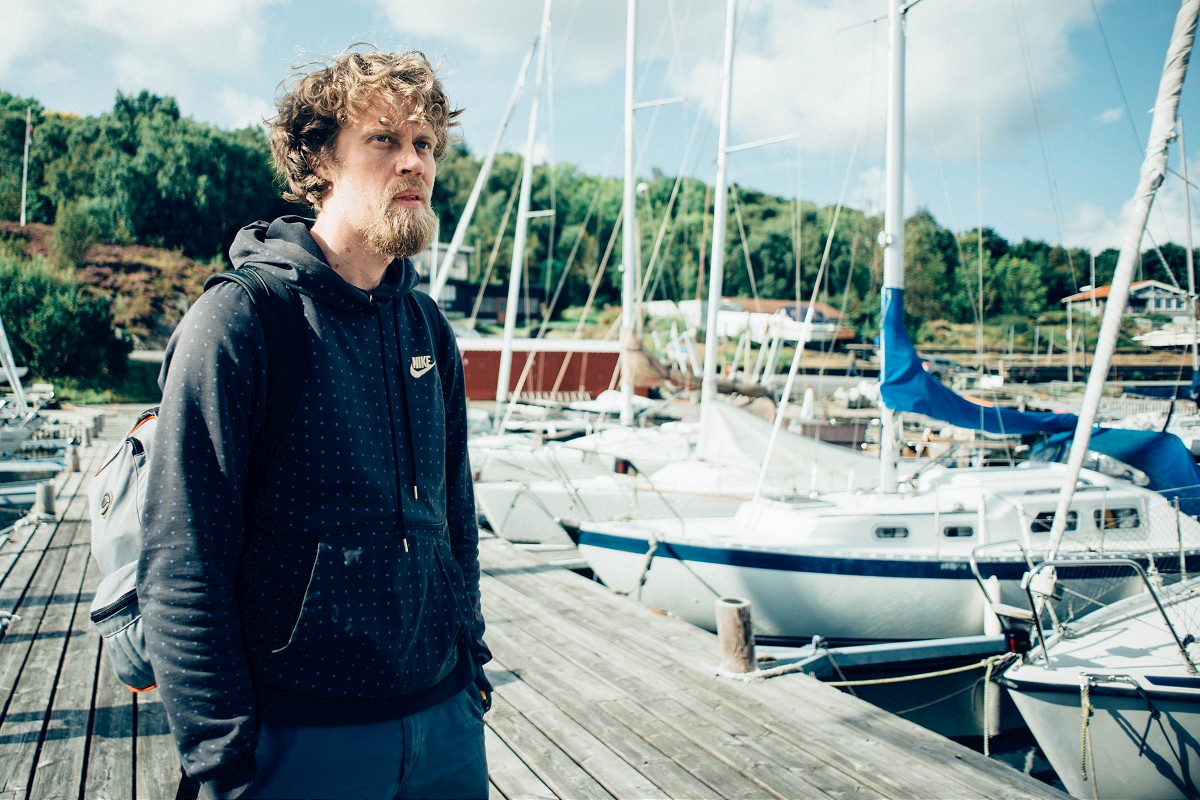It would give a certain pleasure to Walter Benjamin if he could know that 81 years from the first publication of his The Work of Art in the Age of Mechanical Reproduction, it would be quoted by a Russian artist in a perfectly poetic manner just right on the waters of the Norwegian port city of Stavanger. The artist, Igor Ponosov, through his Too far, Too close artwork, not only reminded us about the “aura” and “unique appearance of a distance,” but also interacted with the viewer through some kind of ritual, which according to Benjamin should prove the “authenticity” of this work.
In early September during Nuart Festival (covered), twice a day people in Stavanger could watch the boat with the “eye test chart” on its sail floating around the city in the distance. It was an art object, performative act, poetical allusion and the critical statement, all at the same time. Igor Ponosov says that it’s an “intradepartmental” critique, since the artwork, which was made for the street art festival actually symbolizes the true distance between modern street art and the people, no matter how close this art may be to them physically.
Ponosov is an artist, activist and the author who doesn’t have formal art education. Despite that, his last book was awarded the Sergey Kuryokhin Contemporary Art Award for the “Best Text on Contemporary Art” in 2016. He is the person who’s standing behind the Partizaning.org website and is said to be the first person on Earth who did research on street art in post-soviet territory.

Kristina Borhes (KB): What do you do as an artist?
Igor Ponosov (IP): I work with the city mostly. I think it’s because the urban environment inspires me a lot. There are many elements, which could be combined within the city; many people to communicate with; a lot of meanings you can work with… It is a very fertile environment for creativity. For instance, there is magnificent nature in Stavanger. It’s a kind of nature, which is very inspirational and desirable, you always dream to get there. Even before I got here, I knew it will be like that. That’s why the boat is sort of attempt to reach it (nature). Practically, I was staying in the city since I was sailing only around Stavanger, but anyway I’ve became a little closer to its nature. It was an artistic endeavor to experience the nature. At the same time, it was a chance to tell the people that the city is not only those industrial buildings in “growth decay”, but also everything around Stavanger. And I guess most people were inspired by it. They saw that it’s possible to make something even on the water.

KB: Since you’re working with the context of the place. Did you notice something specific regarding the public space of Stavanger? What thoughts it provoked?
IP: Every city has its specific context. What I’ve noticed here is a very comfortable and safe environment. Again, nature plays a big role, but also there are not many cars in the city, not many people… Perhaps, Stavanger has just the right amount of people and cars which should be in such a small city. That’s why it’s very comfortable to live here. I never saw a cop here and I don’t know where the police department is (I have a doubt that it exists at all), but there’s a strong personal impression of safeness in this city. There are no window grates here, no fences… It is very noticeable, especially when you come from Russia. I’m always renting an apartment in Moscow. Usually, it is on the first or second floor and every time there are grates on windows there. You always feel this border, living as if behind the fence. Once, I even made the design of the window grate as an object in the Russian city and I thought it could be interesting to make one here someday. It’s a quite clear and understandable moment in Russia, but how would people react to it in Stavanger? And is it even possible here? Actually, it’s an important part of any project – to examine how acceptable your idea is in some specific place.

KB: How you came to an idea of the Too far, too close artwork?
IP: Once I was in Nizhny Novgorod, a city with the widest river Volga. This river inspired me a lot, just like Norwegian nature. There are some islands just right on the river. In the frame of an art residency, I’ve asked to bring me to the one of those islands, so I could live there for a couple of days in the tent. I haven’t done anything extra special, but it was a very interesting practice of experiencing the city. You’re kinda in the city, but at the same time you’re not. Just in the middle of “nature” still you can see the urban landscape, city lights, advertisement on the shopping mall, you can hear the church bells… It was definitely an interesting practice. And I wanted to continue it here, but at the same time I wanted to create an object. The object which will be quite poetical, a bit critical, absurd and useful in a way. This is how the image of the sail with the “eye test chart” was born. The “message” on the sail is quite absurd, but at the same time it is somewhat useful, because the boat was sailing at a specific distance from the city, so people could make an eye test.

KB: Tell me more about your “intradepartmental” critique. What do you think is wrong with the street art and muralism?
IP: What concerns me a lot is reproduction of mural art. Walter Benjamin raised the question about the “reproduction” and the “aura” of art back in 30’s… The issue is still actual regarding the context of street art festivals. I don’t see the meaning in massive production of all these abstracts or decorative murals. Most of them are out of context… I’m always trying to be critical and my work “Too far, too close” symbolizes the murals, which are too far from the people because of the abstract message they deliver (just as my sail with an eye test chart), even though they are so close physically to people on the streets.
In fact, most of the street art works nowadays are very flat images. Very often it is just a depiction of a simple object. It’s some kind of a trap for the artist. They’re becoming the prisoners of their own style. Imagine that some artist painted a peg, a very well-done huge peg. And maybe this peg even related to the context of that particular place. But all of a sudden everyone started to ask for the same peg in other places. So, artist changes it a bit, but then decides to develop a set: peg, fork and spoon. He will use this set every time, when somebody invites him to paint. This is how artists are getting trapped. And even well-known and respectable artists are reproducing their own sets of objects, characters or animals… It’s cool to see it once, maybe twice, but I don’t agree to look at the same thing with small variations in every single city. I don’t need it neither as an inhabitant, nor as a guest of the city.
KB: And you as an artist?
IP: As an artist, I don’t like to be the prisoner of the style. It’s not interesting for me to reproduce the same thing. If someone asks me to make another sail, probably I will refuse. There’s no sense in it.

KB: Apparently, attending street art festivals is not in your habit. What is so special about the Nuart? There should be something, since you’re here…
IP: Yeah, it’s not in my habit at all. Usually, I don’t take part in street art festivals. In fact, I’m trying to escape the label – “street art” artist. It’s not that I’m ashamed or something. Many people have the opinion that there are “street art” artists and the “true” artists. I don’t agree with that for sure. But still this “street art” label became mainstream and it provokes associations such asa permanent reproduction of facades, superficial images, lack of work with the context, unfortunately. Frankly saying, I would like it to be different. In my book Art and the city, I’ve tried to find the examples in order to disprove it, but still one way or another this mainstream scene already exists. That’s why street art festivals are not very useful for me personally. I consider myself as just an artist and yes, I like to work with the city, but only because it’s a very fertile environment, nothing more.
I’ve came to Nuart festival, because I consider it as one of the oldest street art festivals and it was curious to kinda watch it from the inside. This festival is changing through development and the line-up of this year is a good proof of that. It is very diverse and interesting.
KB: Ok, let’s talk about your Art and the city book. It was quite resonant on post-soviet territory. How was it started?
IP: I’ve been doing analysis and systematization of the street art starting since 2004. It started with my first website – “Visual Artifacts.” At that time in post-soviet territory, there wasn’t even such a term as “street art.” Well, there was something, but certainly no websites that could present information about it. By that time, I was already bored by tagging. I mean, at that stage for me as an artist it wasn’t interesting to tag in Moscow anymore. So, I started to explore new practices in the context of the city. I was searching for artists on the web, collecting their profiles and then presenting them on my website. Almost immediately, I’ve got an idea about the book. For the next few years, I’ve published 3 books – the series called “Objects.. I’ve made everything by myself in those books and each one became better. It was quite a long process and from time to time I had the feeling as if street art only begins, but at the next moment it immediately dies… At least in Russia. For quite a long time I was doing the lectures and exhibitions regarding the street art topic. In 2012-2013 together with Krill KTO, we’ve been working on the lectures for the university and I thought it could be nice to collect the information obtained through all these years and present it in one single monumental statement – the book. Moreover, there was no such publication in Russia. Well, even on the worldwide scene there are not many books, which systematically explore the wide range of different practices. So, I started to work on the “Art and the city” book.

KB: Was is it easy to publish such book in Russia?
IP: It appeared to be not that easy… I’ve published the “Objects” trilogy at my own expense. This time, I thought that I already outgrew this stage. There were some sponsors willing to cooperate, but I surely didn’t want advertising in my book. I wanted to work with a publishing house this time. I spend almost a year negotiating with different publishing houses. Some of them agreed but then nothing really happened… I guess most of them just wanted to avoid the risk, it’s always easier to work with something you’ve already tried. That’s why I decided to do it by myself again. It’s important for me to finish what I’ve started. Moreover, it was interesting for me to try crowdfunding as a tool. So now I’m really happy that it went this way.
The crowdfunding campaign lasted for 3 months and it showed me that people are interested in this topic, they are ready to be involved, ready to help. Sure, it demands a titanic effort. I was communicating with the people all the time. I don’t like to use social media, but I had to. Despite that, I proved to myself that people care about my work, it’s important for them. I had big support from the graffiti and street art community. As a matter of fact, I was criticizing some of those artists and organizations, but they supported me anyway. It is valuable. During the campaign, I achieved the goal and even a bit more. It was more than enough to publish a book. I guess I’m trying to prove that one person could do a lot of things. You don’t have to wait until someone notices you, or until you have the money or something else. Just start doing something.

KB: Regarding your refusal from advertising in the book. What is your opinion towards art and sponsorship? It seems like politicians and entrepreneurs are actively re-discovering the “power” of street art. I guess both of us can come up with hundreds of dismal examples from Russia and Ukraine.
IP: I’m trying to stay away from the brands, commercial or political organizations. It’s important for me to keep my statement pure. I can’t imagine my boat sailing here under the name of some brand for instance. For me this kind of thing is unacceptable, because in that case it’s only advertising, nothing more. Although, I know many artists who are absolutely ok with such things. It’s their choice. As an artist I don’t care who’s sponsoring other artists, but as curator I prefer to work with artists which are motivated by themselves rather than by sponsors. Usually, you can feel it on the personal level: sometimes it’s just some single cooperation and it doesn’t affect the artist’s practice, the other time you can feel its domination throughout artist’s work. Capitalism takes every underground culture and converts it in the mainstream. This is what really happened with the street art. It’s a well-established practice and artists are only cogs in its wheel.
KB: As you’ve mentioned earlier, sometimes you feel that street art dies. Some of intellectuals already declared the death of graffiti, death of street art, or death of Postmodernism… So now we have Schacter’s “Intermural Art” or “Post-Street Art” from Martyn Reed as the new terms for the new practices somewhere in the middle of the streets and galleries/museums. Is it really dead?
IP: Well, I agree that it is an absolutely a different practice. For me, street art is a grassroots practice, it is illegal, a protest in some way, politically or socially engaged… You can hardly find such messages today… It’s not the same “street art” as it was at the beginning. After I published three of my “Objects” books, I said the same thing about Russian street art, it died for me. I saw no development of street art in the context of Russia. Artists didn’t pay attention to local context. Most of these practices came from the West, frequently it was just reproduction of Western images. Later I had an impression that it revived for a certain moment. It was 2011, when some protest things appeared, artists in Russia started to work with local context. I still see them now, but prefer to remove the “street art” label from their practices. Most likely, the “Art and the City” book is kinda the final point in my street art “digging”… This topic became very mainstream, some kind of niche or even “ghetto” in the context of contemporary art. From time to time, contemporary art institutions are trying to represent the processes, which are going on within the street art, but usually they don’t understand a thing about it. They will randomly pick something from the surface and put it into the museum, or biennale. As a rule, it’s something like “we will give you that far corner, spray something on it.” In the end, it looks like some roadside… And I don’t like it, because if you’re an artist – please represent yourself equally with other artists. If you prefer to work with the city context that’s ok, but why do you have to label yourself?
Photo credit: Kristina Borhes and the artist



